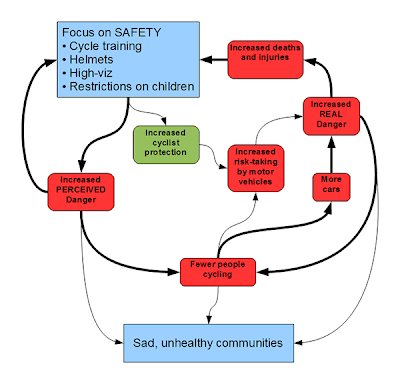I've been thinking about the "war on the motorist" and the terrorising of our residential streets by motor vehicles, coupled with a media interest in cycle "helmets" and the dangers of cycling in the UK. What are we doing? I think there are two different ways of approaching the problem.
Increased Safety for Cyclists
A large amount of effort is being focussed on increasing safety for cyclists, without making any changes to motorists at all. We see strong campaigns for cyclists to always wear "helmets", high-visibility clothing, and to take BikeAbility training courses to learn how to deal with motor traffic. The emphasis is entirely on getting cyclists to make changes.
Here is a cause-and-effect diagram I created to show how this creates an "arms race" between the danger caused by the motor vehicles, and the safety measures required by cyclists:
Here, we get perhaps some benefit from giving cyclists more protection, but we don't actually get very many new people cycling. In fact the safety equipment and training we're encouraging makes it clear to non-cyclists that their fears about the dangers of cycling are completely justified.
The reduction in danger possible by wearing polystyrene hats, or flourescent clothing, is minimal. These won't protect you if a distracted car driver drives into you. The benefits of training are also, I think, overstated. Even experienced cyclists are being killed on our roads, not just novices.
The diagram shows several vicious circles, that keep the cycle going:
- Perceived danger → More calls for safety equipment → Increased perceived danger.
- Real danger → Fewer people cycling →More cars →Increased real danger.
- Calls for safety equipment → Perceived danger → Fewer people cycling →More cars →Increased real danger → Increased deaths and injuries → More calls for safety equipment.
The main benefit of this approach is that it's very cheap. Cyclists actually pay for their own protection, and keeping children indoors doesn't cost anything.
This is an arms race, just like those between warring nations, and like our "war on terror" where every action prompts a bigger reaction. There is no way this can lead to more people cycling as a normal mode of transport. It results in people's freedoms being restricted, and much pain and suffering.
Reduced Road Danger
The opposite way of approaching the problem is to focus on the causes of the danger, rather on the safety of the victims.
Here is a similar cause-and-effect diagram:
Here we have fewer circles, and they're no longer vicious ones. In fact, the whole effect is remarkably more pleasant.
The only problem with this approach is that it's more expensive and time-consuming than getting cyclists to protect themselves. However the Dutch and Danish have shown what can be done with the right political will and a decade or two of time. Cycle facilities are orders of magnitude cheaper than motorways, and 20's Plenty for Us is extremely cost-effective.
This is disarmament: everyone lays down their weapons, the two sides talk to each other, and peace prevails. What's more, there are no vicious circles: once we've removed the danger we can relax and enjoy life!



5 comments:
Great article! My only concern is with the segregation aspect (I am pro-segregation, btw).
Integrationists would probably say that segregation increases the perceived danger of cycling by making it seem only to be possible using special infrastructure, while simultaneously reducing the actual danger.
This is, of course, apart from Franklin and Forester, who still believe - in spite of the evidence from NL and DK - that segregation is more dangerous than integration.
Good point, having good quality segregated infrastructure would indeed make cycling without such infrastructure look dangerous. But we're there already!
I'd imagine a Dutch person trying to ride their bike for transport in the UK would very quickly give up, or might not even try: they would see the perceived danger as being too great.
But segregated infrastructure would, as you say, dramatically reduce the real and perceived danger of cycling where that infrastructure exists. For an example, cycling as transport has dramatically increased here along the seafront near Worthing since the segregated cycle route has been open, and cycling allowed on the Promenade.
Frankin and Forester are quite correct if you take segregation as typically implemented in the UK: white lines on the pavement. They, like many traditional cycling campaigners, just don't think we can ever segregate properly like the Dutch do. I think we have to, if we want to see any significant modal shift to cycling as transport.
Which is why "traditional cycling campaigners" are no longer voice that should be listened to. Time for a paradigm shift in bicycle advocacy. Back to the basics. Back to mainstream marketing instead of sub-cultural whining.
There are dozens of cities around the world, in Emerging Bicycle Cultures similar to the UK, who are making "traditional cycling campaigners" look increasingly hapless, outdated and irrelevant.
I agree with your analysis
Just one small problem with the solution though. Where are these "quality cycle facilities" gonna come from?
99% of the current ones I've seen in the UK are rubbish.
@audaxing: easy, from Highways budgets. Since both national and local government needs to cut spending, an ideal way to do this would be to invest in cycling infrastructure, instead of motor car infrastructure. The former is massively cheaper, and provides transport for a larger proportion of society. Providing for cycling also benefits society in many ways, compared to the serious dis-benefits of encouraging more motor vehicle use.
For example, West Sussex County Council have a Highways budget for 2011/2012 of £49 million (source: council tax leaflet). If they chose to spend, say, 10% of that on cycle infrastructure we could build £4.9 million's worth of decent Dutch-style facilities. In just this year. There is no lack of money, there is only lack of political understanding.
Post a Comment